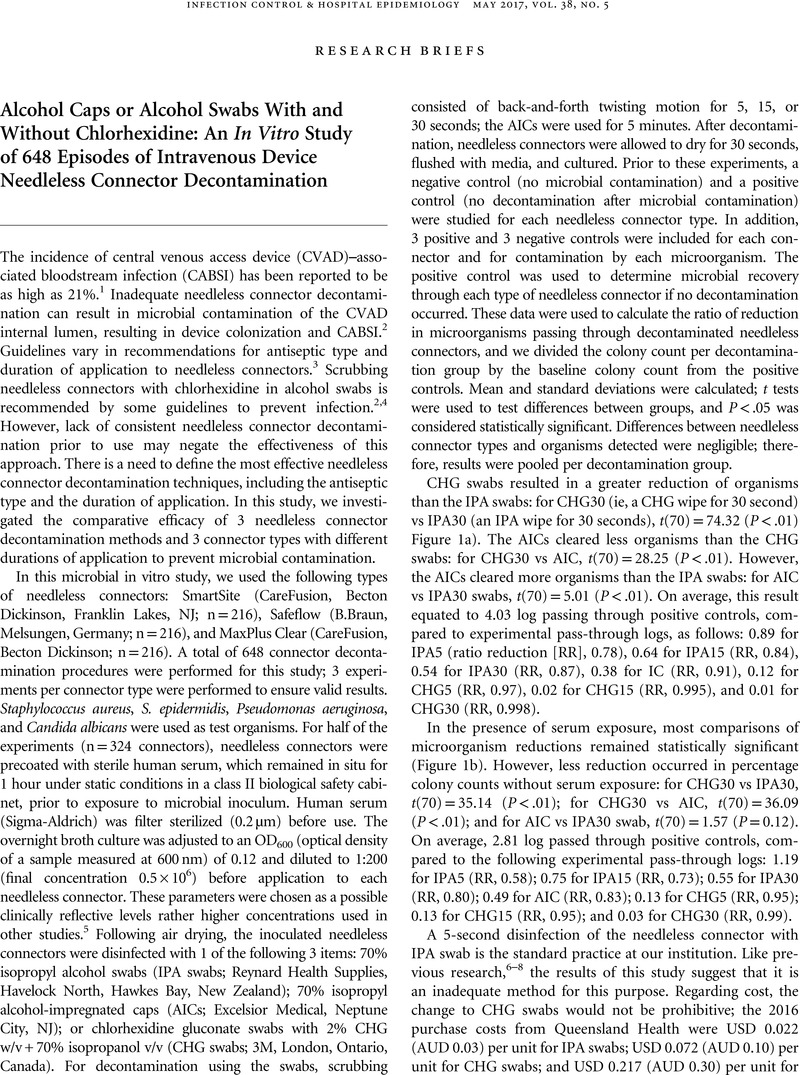Crossref Citations
This article has been cited by the following publications. This list is generated based on data provided by Crossref.
Fernández Moreno, I.
and
Píriz Marabaján, M.
2019.
Antisepsia en la manipulación de las conexiones de los accesos vasculares.
Medicina Intensiva,
Vol. 43,
Issue. ,
p.
44.
Flynn, Julie M.
Larsen, Emily N.
Keogh, Samantha
Ullman, Amanda J.
and
Rickard, Claire M.
2019.
Methods for microbial needleless connector decontamination: A systematic review and meta-analysis.
American Journal of Infection Control,
Vol. 47,
Issue. 8,
p.
956.
Hallam, Carole
2019.
Vessel Health and Preservation: The Right Approach for Vascular Access.
p.
235.
Nickel, Barb
2020.
Hiding in Plain Sight: Peripheral Intravenous Catheter Infections.
Critical Care Nurse,
Vol. 40,
Issue. 5,
p.
57.
Rickard, Claire M
Flynn, Julie
Larsen, Emily
Mihala, Gabor
Playford, E Geoffrey
Shaw, Joanie
Keogh, Samantha
Ullman, Amanda
Zhang, Li
Gavin, Nicole
Kleidon, Tricia
Chopra, Vineet
McCarthy, Alexandra L.
Rocha, Patricia Kuerten
and
Marsh, Nicole
2021.
Needleless connector decontamination for prevention of central venous access device infection: A pilot randomized controlled trial.
American Journal of Infection Control,
Vol. 49,
Issue. 2,
p.
269.
Greene, E.S.
2021.
Challenges in reducing the risk of infection when accessing vascular catheters.
Journal of Hospital Infection,
Vol. 113,
Issue. ,
p.
130.
Dalcin, Camila Biazus
Souza, Sabrina de
Anders, Jane Cristina
Pina, Juliana Coelho
Carmo, Andréia Cristina Feitosa do
Manzo, Bruna Figueiredo
and
Rocha, Patrícia Kuerten
2022.
Desinfecção de hubs e conectores de cateteres intravenosos.
REME-Revista Mineira de Enfermagem,
Vol. 26,
Issue. ,
Rocha, Patrícia Kuerten
Rickard, Claire M.
Gales, Ana Cristina
Sincero, Thaís Cristine Marques
Ray-Barruel, Gillian
Ullman, Amanda J.
Dalcin, Camila Biazus
and
Pedreira, Mavilde L. Gonçalves
2022.
Disinfection of needleless connectors to reduce Staphylococcus aureus bacterial load.
British Journal of Nursing,
Vol. 31,
Issue. 19,
p.
S26.
Larsen, Emily N.
August, Deanne
Keogh, Samantha
Flynn, Julie
Ullman, Amanda J.
Marsh, Nicole
Cooke, Marie
McCarthy, Alexandra L.
and
Rickard, Claire M.
2022.
Evaluating methods for the use and decontamination of needleless connectors: A qualitative inquiry.
Infection, Disease & Health,
Vol. 27,
Issue. 4,
p.
175.
Rocha, Patrícia Kuerten
Rickard, Claire M.
Gales, Ana Cristina
Sincero, Thaís Cristine Marques
Ray-Barruel, Gillian
Ullman, Amanda J.
Dalcin, Camila Biazus
and
Gonçalves Pedreira, Mavilde L.
2022.
Disinfection of Needleless Connectors to Reduce Staphylococcus aureus Bacterial Load.
Journal of the Association for Vascular Access,
Vol. 27,
Issue. 2,
p.
14.
Roberts, Scott C.
Hendrix, Curtis A.
Edwards, Lauren M.
Feinn, Richard S.
Martinello, Richard A.
and
Murray, Thomas S.
2023.
A mixed-methods evaluation on the efficacy and perceptions of needleless connector disinfectants.
Infection Control & Hospital Epidemiology,
Vol. 44,
Issue. 2,
p.
230.
Hallam, Carole
2024.
Vessel Health and Preservation: The Right Approach for Vascular Access.
p.
319.



